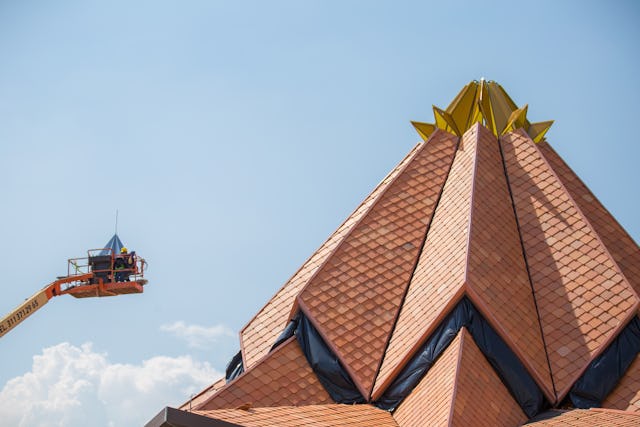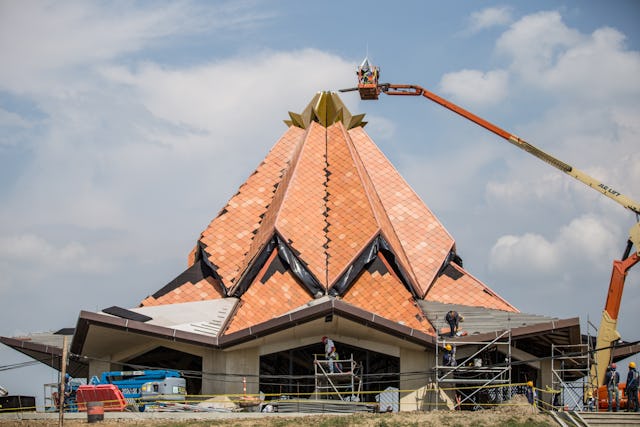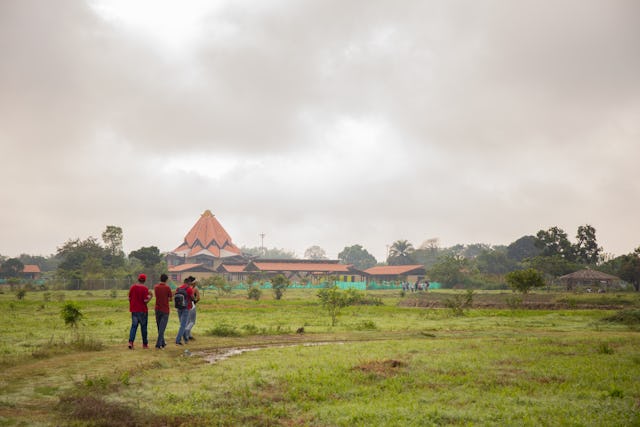Flower of Colombia Temple Blooms
AGUA AZUL, Colombia — The crown at the top of the roof of the local Baha’i House of Worship in Colombia has been installed, marking an important milestone for this historic initiative.
The yellow structure that sits atop the terracotta-tiled roof represents the blooming cocoa flower—an iconic symbol in the country—and was put into place soon after the first day of spring, which corresponds with the Baha’i New Year. It is made out of a fluorescent material that absorbs sunlight in the day and lights up naturally with the sunset.
In the coming weeks, a calligraphic rendering of the word ‘Baha,’ meaning glory, will be installed within the roof’s crown. Every Baha’i House of Worship has a variation of this sacred symbol within it.
Ever since the temple was announced by the Universal House of Justice in 2012, surrounding communities have felt a sense of collective ownership for its development.
“The construction of the Temple has certainly had an impact on the community,” said local youth Jean Paul Viafara Mora, age 18. “It has opened a healthy space for people to enter, and provided an alternative to the kinds of activities people undertake that may not be very good for them.”
He continued: “The Faith has a spiritual potency that is affecting all of us, contributing to our spiritual development and connection with our Creator.”
As the project has progressed, efforts to build a spiritually and materially vibrant community have advanced together with the construction. For the last five years, members of the community have been working on a reforestation project on the grounds of the House of Worship. The initiative has helped to reintroduce native vegetation to the area, which was decimated by the proliferation of sugarcane plantations across the land over many decades.
The revival of the natural habitat in Norte del Cauca has corresponded with a spiritual awakening in the population, where gatherings for prayers in all kinds of settings bring together neighbors in a spirit of unity and love. Many from among the population have found common paths of service to the community, strengthening neighborly bonds while working shoulder to shoulder.
A major aspect of the reforestation project has been the spiritual connection between the people and the land. The community often holds devotional meetings on the land of the Bosque Nativo, or native forest, in the mornings before commencing work.
These developments have attracted the attention of many in the region, including local Mayor Jenny Nair Gomez, who recently visited the Temple grounds. She expressed her eagerness for the Temple to open to the people soon, and it is clear that she shares the community’s enthusiasm about the impact of this major development for the area. Mayor Nair Gomez committed herself to working for positive social progress alongside the many people who have been inspired by the Temple.
(Editor's note: An earlier version of this story incorrectly stated in paragraph 3 that all Baha'i Houses of Worship have the Greatest Name symbol raised at the apex of the roof. This was corrected on 8 April 2018.)


